“SPI LED strips offer individual LED control for advanced, dynamic lighting effects. PWM LED strips provide simple, effective lighting control ideal for uniform illumination. Clearly understanding these differences helps you select the optimal solution for your needs.”
Introduction to SPI and PWM LED Strips
Having personally installed both SPI and PWM LED strips in various lighting projects, I clearly understand their distinct features. Here’s a straightforward explanation to help you select the best solution for your specific needs.
What Are SPI LED Strips?
SPI (Serial Peripheral Interface) LED strips provide individual control of each LED or segment through data signals. This allows dynamic lighting effects, animations, and detailed customization. From my experience, SPI strips are ideal for advanced decorative lighting, events, or complex visual displays.
What Are PWM LED Strips?
PWM (Pulse Width Modulation) LED strips control brightness and color by adjusting power through pulse modulation. They provide uniform lighting effects across entire strips or larger segments. PWM strips are clearly suited to simpler, consistent illumination applications, such as general accent lighting and straightforward decorative setups.
People frequently ask me, “What’s the main difference between SPI and PWM LED strips?” Clearly, the primary difference is the level of control—SPI offers individual LED control for dynamic effects, while PWM provides simpler control over entire strips or large segments.

Technical Differences Clearly Explained
From my hands-on experience installing SPI and PWM LED strips, I’ve clearly identified key technical distinctions that will guide you in making the right lighting choice.
Lighting Control & Customization
- SPI LED Strips:
Offer individual or segment-specific control through data signals, clearly enabling complex animations, dynamic effects, and detailed customization.
- PWM LED Strips:
Provide uniform brightness control across the entire strip or larger segments, clearly ideal for consistent, simpler lighting setups.
Brightness & Lighting Quality
- SPI LED Strips:
Allow precise brightness adjustments per LED or segment, clearly enhancing dynamic visual effects and detailed lighting scenes.
- PWM LED Strips:
Deliver uniform brightness suited to general accent lighting or simple decorative applications, clearly without individual LED customization.
Installation Complexity & Flexibility
- SPI LED Strips:
Require detailed planning for data wiring, compatible controllers, and power supply clearly due to their advanced control capability.
- PWM LED Strips:
Feature simpler installation requirements, clearly suitable for straightforward setups and easier DIY projects.
Clients frequently ask me, “Is SPI better than PWM for LED lighting?” Clearly, SPI is preferable for dynamic, detailed lighting scenarios requiring individual LED control, whereas PWM is ideal for simpler, uniform lighting applications.
Comparison Table:
| Feature |
SPI LED Strips |
PWM LED Strips |
| Control Method |
Individual LED or segments |
Entire strip or segments |
| Brightness Customization |
High, detailed control |
Moderate, uniform |
| تعقيد التركيب |
Moderate to high complexity |
Moderate, simpler |
| Ideal Applications |
Detailed decorative lighting |
General accent lighting |
| التكلفة |
Higher initial cost |
Cost-effective |
Advantages and Disadvantages of SPI LED Strips
From my direct experience installing SPI LED strips, I clearly understand their practical strengths and limitations. Here’s a straightforward breakdown to guide your selection process effectively.
Advantages of SPI LED Strips
- Individual LED Control:
Clearly allows dynamic and complex lighting effects, enabling precise and detailed customization for visually impactful designs.
- Enhanced Visual Effects:
Ideal for creating advanced lighting animations, detailed color transitions, and intricate decorative patterns.
- Versatile Applications:
Clearly suitable for event lighting, detailed commercial displays, entertainment spaces, and dynamic residential installations.
Disadvantages of SPI LED Strips
- Higher Installation Complexity:
Require detailed planning, compatible controllers, and additional wiring clearly necessary for effective installation.
- Increased Initial Cost:
Typically more expensive upfront due to advanced control capabilities and specialized controllers required.
- Detailed Maintenance Needs:
Clearly require more careful handling, periodic inspection, and detailed troubleshooting due to their complexity.
Clients frequently ask me, “Are SPI LED strips worth the extra complexity?” Clearly, if dynamic effects, detailed customization, and visual impact are your priorities, the additional complexity and cost of SPI LED strips are justified.
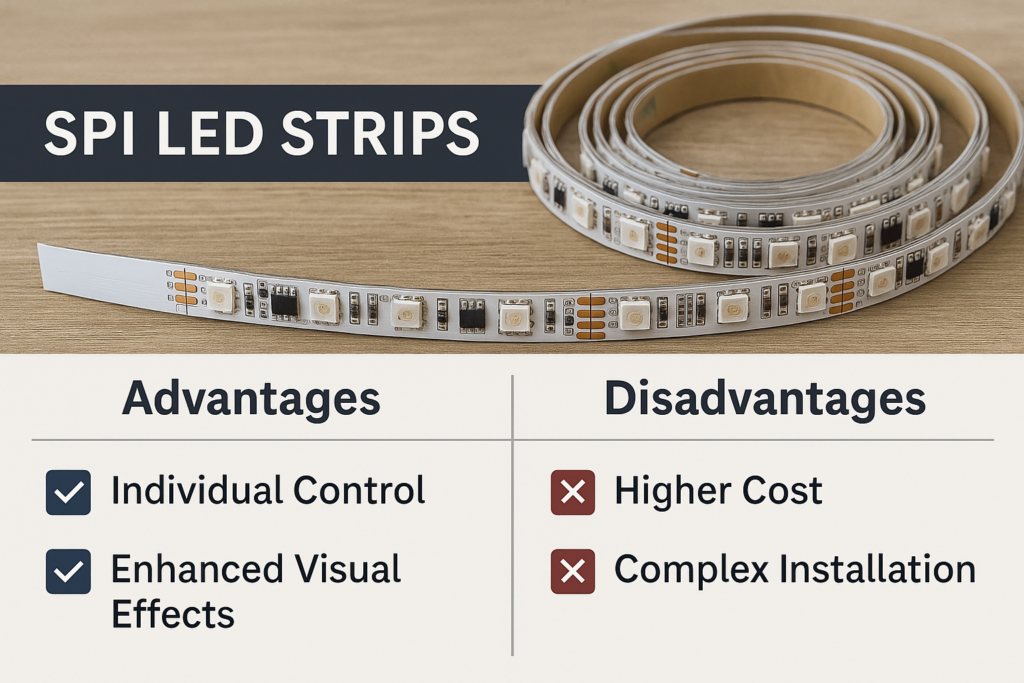
Advantages and Disadvantages of PWM LED Strips
From my extensive experience installing PWM LED strips, I’ve clearly seen their practical strengths and limitations. Here’s a straightforward breakdown to guide you effectively in your lighting decisions.
Advantages of PWM LED Strips
- Simple Installation:
PWM strips offer straightforward installation clearly suited for DIY projects and general lighting setups.
- Cost-Effective:
Clearly provide an affordable lighting solution suitable for budget-conscious projects.
- Reliable and Consistent Lighting:
Deliver uniform brightness, clearly ideal for ambient, decorative, or accent lighting without complex effects.
Disadvantages of PWM LED Strips
- Limited Customization:
Clearly unable to control individual LEDs for detailed or dynamic lighting effects.
- Moderate Brightness Flexibility:
Offer less precise brightness adjustment compared to SPI strips, clearly limiting their versatility in detailed lighting scenarios.
Clients frequently ask me, “Are PWM LED strips bright enough for detailed task lighting?” Clearly, while PWM LED strips are ideal for uniform, general illumination, they are less effective for detailed or dynamic lighting projects requiring individual LED control.
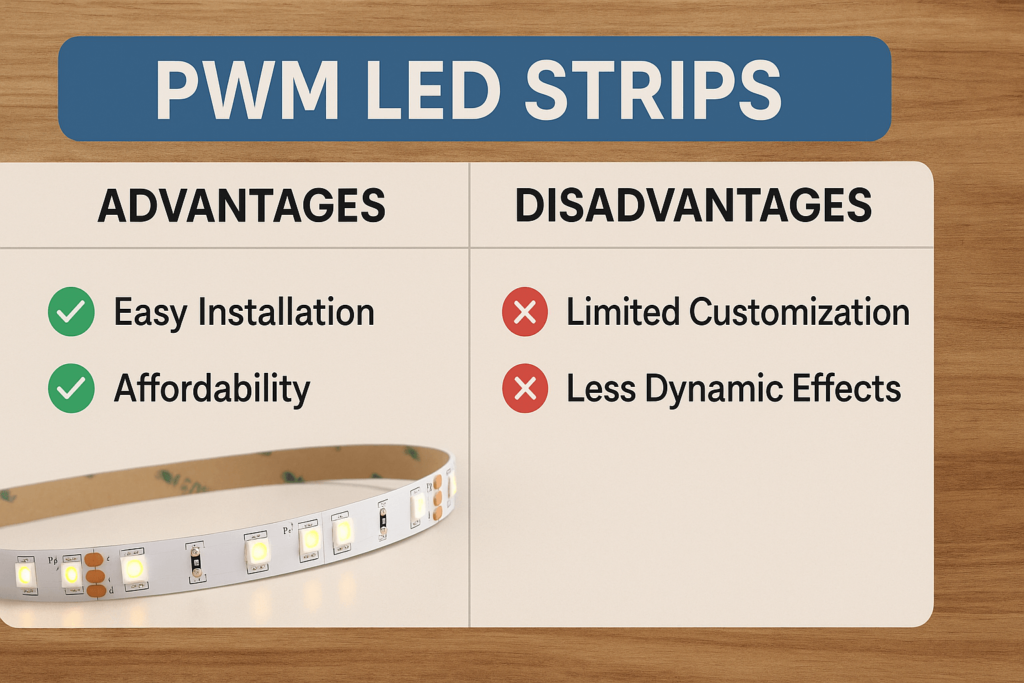
Best Applications & Practical Scenarios
Drawing from my practical experience with both SPI and PWM LED strips, I can clearly identify the ideal scenarios for each. Here’s straightforward guidance to help you select the perfect lighting solution for your project:
Ideal Uses for SPI LED Strips
SPI LED strips clearly excel in dynamic, customized lighting applications, including:
- Event & Stage Lighting:
Perfect for concerts, performances, or events clearly requiring vibrant and dynamic lighting effects.
- Commercial Displays:
Clearly suitable for attention-grabbing storefronts, detailed product showcases, or complex decorative installations.
- Entertainment Spaces:
Ideal for gaming rooms, home theaters, and entertainment venues needing customizable and visually impactful lighting.
Ideal Uses for PWM LED Strips
PWM LED strips clearly perform best in uniform, straightforward lighting scenarios such as:
- Residential Accent Lighting:
Ideal for kitchens, under-cabinet setups, bedrooms, and ambient home environments requiring consistent lighting.
- Simple Commercial Installations:
Perfect for store shelves, general retail lighting, and spaces clearly benefiting from easy, reliable illumination.
- Basic Decorative Lighting:
Clearly suitable for creating ambiance in restaurants, cafes, or simple decorative lighting projects.
Clients often ask me, “Should I use SPI or PWM LED strips for residential lighting?” Clearly, SPI LED strips are ideal for residential spaces needing dynamic, decorative effects, while PWM strips clearly suit simpler, uniform illumination needs.
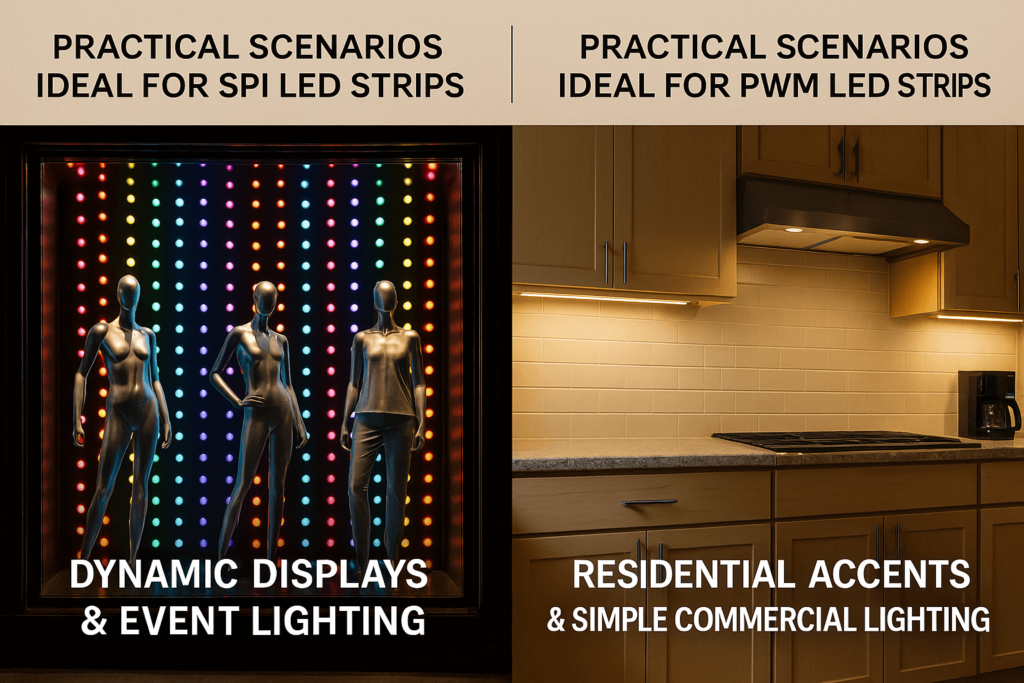
How to Choose Between SPI and PWM LED Strips
Drawing on my extensive experience installing both SPI and PWM LED strips, I clearly understand the essential considerations for selecting the best lighting solution. Here’s straightforward guidance to help you make an informed decision.
Key Decision Factors
- Desired Lighting Effects:
Clearly evaluate if your project requires dynamic, detailed, customizable lighting (SPI) or uniform, simpler illumination (PWM).
- Installation Complexity:
PWM LED strips clearly offer simpler installation ideal for straightforward lighting setups. SPI strips require additional planning, specialized controllers, and detailed wiring.
- Budget Considerations:
PWM strips are typically more budget-friendly and clearly suitable for cost-sensitive projects, while SPI strips offer enhanced features at a higher initial cost.
- Project Application & Environment:
SPI strips are ideal for events, detailed displays, and decorative spaces clearly needing dynamic effects. PWM strips clearly excel in general residential or straightforward commercial lighting scenarios.
Common Mistakes & Practical Recommendations
- Overestimating Complexity Needs:
Avoid unnecessarily selecting SPI strips for basic lighting tasks. Clearly match lighting complexity to your actual needs.
- Underestimating Installation Requirements:
Clearly plan ahead for detailed wiring, power supply, and controller compatibility, especially when choosing SPI LED strips.
- Choosing Solely Based on Price:
Clearly assess long-term functionality and lighting effects rather than just upfront costs, ensuring the lighting solution aligns clearly with your project objectives.
Clients frequently ask, “Is SPI always better than PWM for LED lighting?” Clearly, SPI LED strips are better for detailed, dynamic effects, while PWM LED strips clearly suit simpler, reliable illumination tasks.
External Link:
SPI vs PWM LED Strip Control – LEDSupply
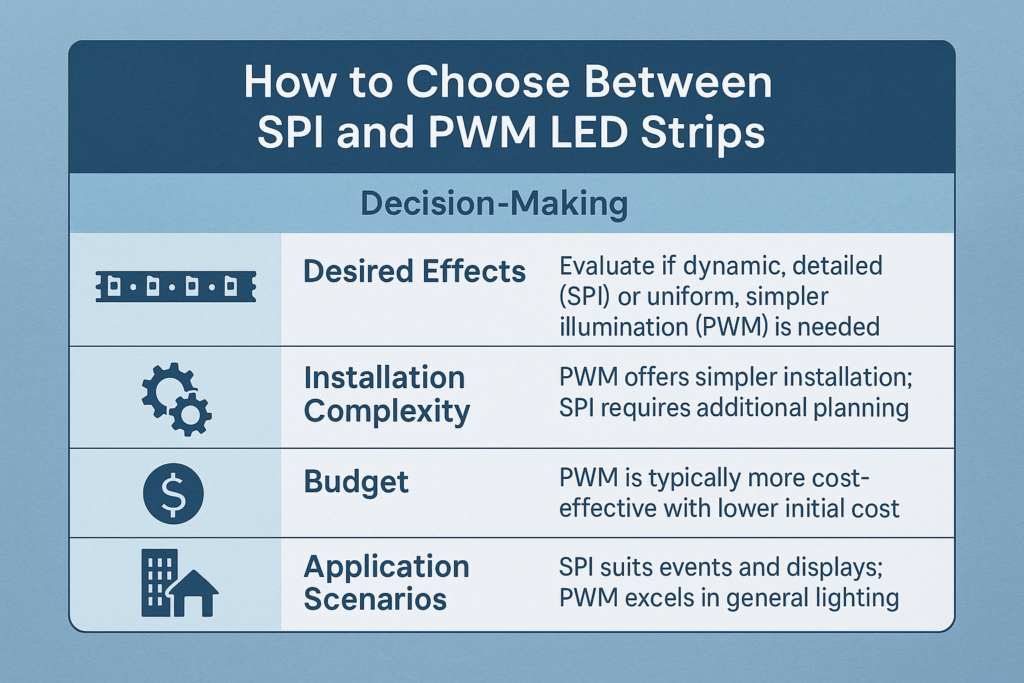
Installation, Maintenance & Expert Recommendations
Having personally installed both SPI and PWM LED strips, I understand clearly how to handle their installation, maintenance, and potential troubleshooting. Here’s straightforward and practical advice based on my direct experience:
Installation Recommendations
- SPI LED Strips:
SPI installations require careful planning for power supply, compatible controllers, and data wiring. Clearly ensure correct connections, precise placement, and adequate heat dissipation for reliable performance.
- PWM LED Strips:
PWM strips offer simpler installation. Clearly plan layout, use adhesive backing or mounting clips, and connect to compatible controllers and power sources, making installation easy and straightforward.
Essential Maintenance Practices
- Regular Inspections:
Clearly inspect LED strips periodically for secure connections, consistent brightness, and signs of wear or damage.
- Proper Heat Management:
Ensure clear heat dissipation, particularly important for high-brightness SPI installations, by using mounting channels or aluminum heat sinks.
- Routine Cleaning:
Gently clean LED strips with a soft cloth clearly to maintain brightness, appearance, and consistent lighting performance.
استكشاف المشكلات الشائعة وإصلاحها
- Inconsistent Brightness or Color Issues:
Clearly check compatibility of controllers, correct wiring, and adequate power supply to ensure stable performance.
- LED Strips Not Lighting:
Verify clearly correct polarity, secure connections, and proper controller compatibility to promptly resolve any issues.
- Installation Adhesion or Mounting Problems:
Clearly prepare surfaces properly and consider additional mounting methods like clips or channels for secure installations.
Clients frequently ask me, “What common issues occur during SPI and PWM LED strip installation?” Clearly, typical issues include incorrect wiring, inadequate power supply planning, insufficient heat dissipation, and compatibility challenges with controllers.
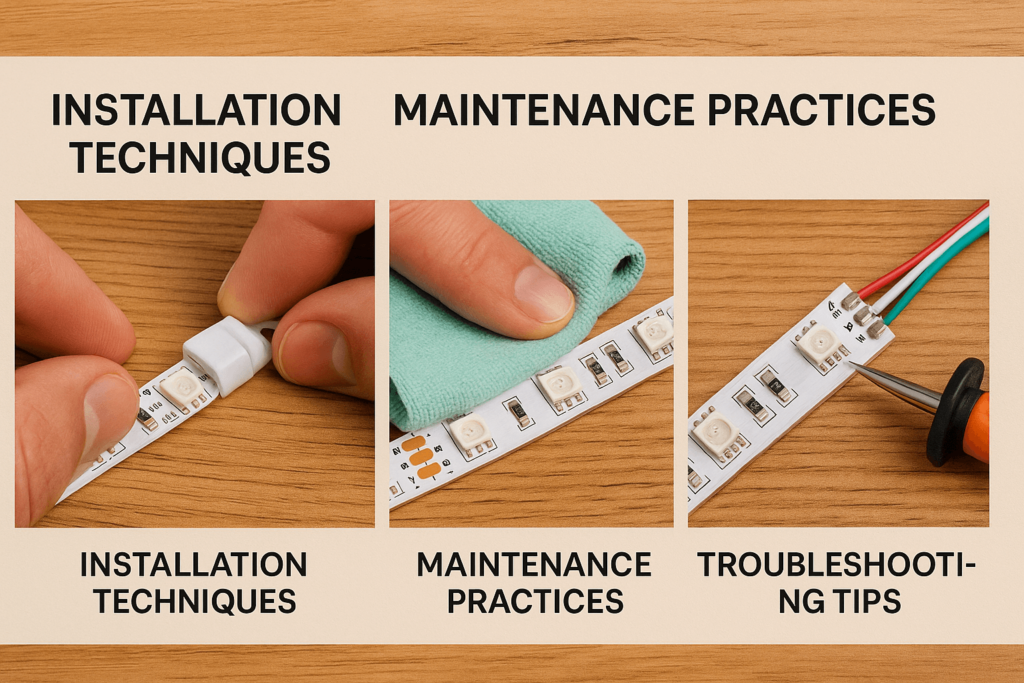
FAQs About SPI and PWM LED Strips
Having installed SPI and PWM LED strips in numerous projects, I clearly understand the common questions people have. Here are straightforward answers to help you easily select the best lighting solution.
What is the difference between SPI and PWM LED strips?
The key difference is the control method. SPI strips enable individual LED or segment-specific control for dynamic and detailed effects, while PWM strips provide uniform brightness control suitable for simpler lighting setups.
Is SPI better than PWM for LED lighting?
Clearly, it depends on your lighting needs. SPI is better if your project requires dynamic, detailed effects and individual control. PWM is ideal for simpler, uniform lighting applications that do not need complex lighting effects.
Which control method is best for RGB LED strips?
For detailed, customizable, and dynamic lighting, SPI is clearly superior. For basic decorative or straightforward illumination, PWM provides a simpler and more cost-effective solution.
Conclusion & Next Steps
Clearly understanding the differences between SPI and PWM LED strips enables you to confidently select the ideal lighting solution for your needs. From my practical experience, SPI LED strips are ideal for dynamic, detailed, and customizable lighting effects, while PWM LED strips provide straightforward, uniform, and cost-effective lighting solutions suitable for simpler applications.
Carefully assess your specific requirements—desired lighting effects, installation complexity, and budget—to make an informed and confident decision.
Ready to find the perfect LED strip lighting for your project?
Explore Elstar’s LED Lighting Solutions →







